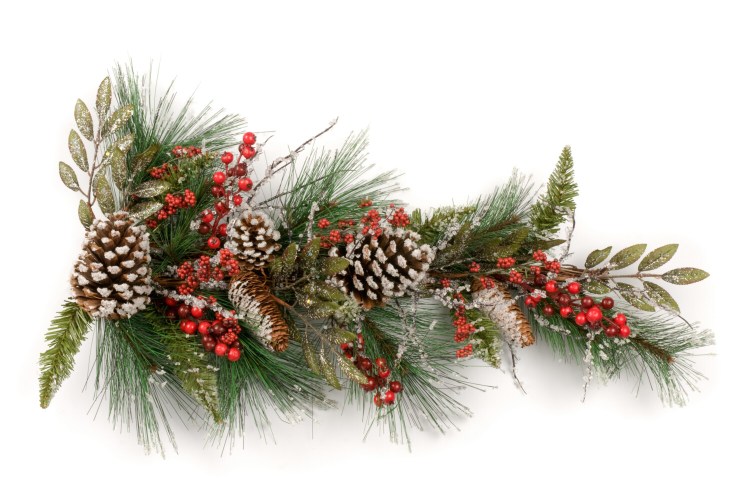We’re about two weeks from the winter solstice. The next month is the darkest and dreariest time of the year in Maine. The landscape is drab, gray and brown – especially if there is no snow cover. And that is only during the minuscule third of the day that the sun is out.
This pervading darkness is a good excuse to brighten up the house’s interior with decorations – even if your family doesn’t celebrate Christmas. Your eyes need some color, and it helps if some of that color comes from recently alive plant material – although I admit I have a bias.
The first step is to grab some hand pruners and take a walk around your yard. Yes, it’s cold, so bundle up. You’ll be out there for an hour at most, the exercise and fresh air will be good for you, and you can reward yourself with a hot chocolate or a hot toddy when you come back inside.
See what stands out in the mostly barren landscape, and consider those items for cutting – as long as you don’t cut so much it threatens the plant’s health. The standard rule for pruning – and cutting branches for their beauty instead of (or in addition to) the health of the plant – is to remove no more than a third of the plant.
The most common plants to cut are needled evergreens – fir, spruce, pine, yews and similar plants. Most wreaths, garlands and centerpieces are made of fir because of its attractive aroma and ability to last a long time indoors. But all of the needled evergreens work. While cutting evergreens, look for the cones the tree might have grown and dropped. They are a traditional decorative accent.
Broadleaf evergreens – with one exception – are less popular for winter arrangements than needled evergreens. Still, there is no reason not to cut some rhododendron, azalea or mountain laurel branches for indoor use. They have a different look and will hold up well.

Ilex aquifolium, aka Christmas holly. nnattalli/Shutterstock
The exception is holly, which many of us use in holiday arrangements, both for its bright red berries and its glossy green leaves. The hollies most common in Maine are Meserve hybrids, which I wrote about two years ago. Remember, you need a male plant for pollination so that the female plant can produce flowers and berries. Also, these hollies quickly grow up to eight feet tall, which means each plant can produce a lot of cuttings in December. And, no, it will not hurt your evergreen shrubs to be pruned at this time of year. Just use sharp pruners and make clean cuts. You may need your loppers if you decide to prune a branch that is more than one inch thick.
We also planted a native holly (winterberry) a couple of years ago, but it is young and small and has yet to produce berries. Native winterberry isn’t evergreen but is often seen in ditches beside the road, under power lines and elsewhere in the wild, where its red berries really stand out because of the defoliated branches. While I would not suggest that you go onto private property or public parkland to cut winterberries (birds and other wildlife devour them, and this is a hungry time of year for wildlife), I doubt you would get into trouble for cutting some from a roadside ditch. Keep out of the way of traffic, however.
Don’t ignore bare branches as part of your decorations. Red twig dogwood is an easy-to-grow native, and its shoots – cut as closely to the ground as possible – can be a wonderful part of winter arrangements.
You can cut as much as you want for a couple of reasons. First, they are aggressive and will spread if left on their own. Second, the youngest shoots are the brightest red, so you want to cut back as many shoots as possible before they get old and drab.
Cutting a few branches from other trees or shrubs – birch and ninebark come to mind – are excellent additions to arrangements.
This might be sacrilegious in a gardening column, but you also can buy flowers and other material for your holiday arrangements. Flower shops sell mixed bunches of flowers at a reasonable price. And supermarkets sometimes have flowers that are both interesting and fresh. Take advantage and practice doing your own arrangements.
Whether you are cutting material in your own yard or bringing it home from the store, put the material in water immediately to keep it fresh. If the piece has a woody stem, split it with your hand pruners before putting it in water. Florist pouches of plant food that you often get with a bouquet actually work. Use them.
The designs don’t have to be complicated. Just stick them in a vase. If you want, use Oasis (a sponge-like invention that holds water into which you poke plant stems) or other flower-design tools. Keep in mind that Oasis is a plastic-based material, so consider investing in metal pin holders instead.
Even if the ultimate arrangement is going to be something like a wreath where the stem won’t be in water, keeping it hydrated until you make the arrangement will keep your decorations fresh longer.
Tom Atwell is a freelance writer gardening in Cape Elizabeth. He can be contacted at: tomatwell@me.com.
Send questions/comments to the editors.



Comments are no longer available on this story